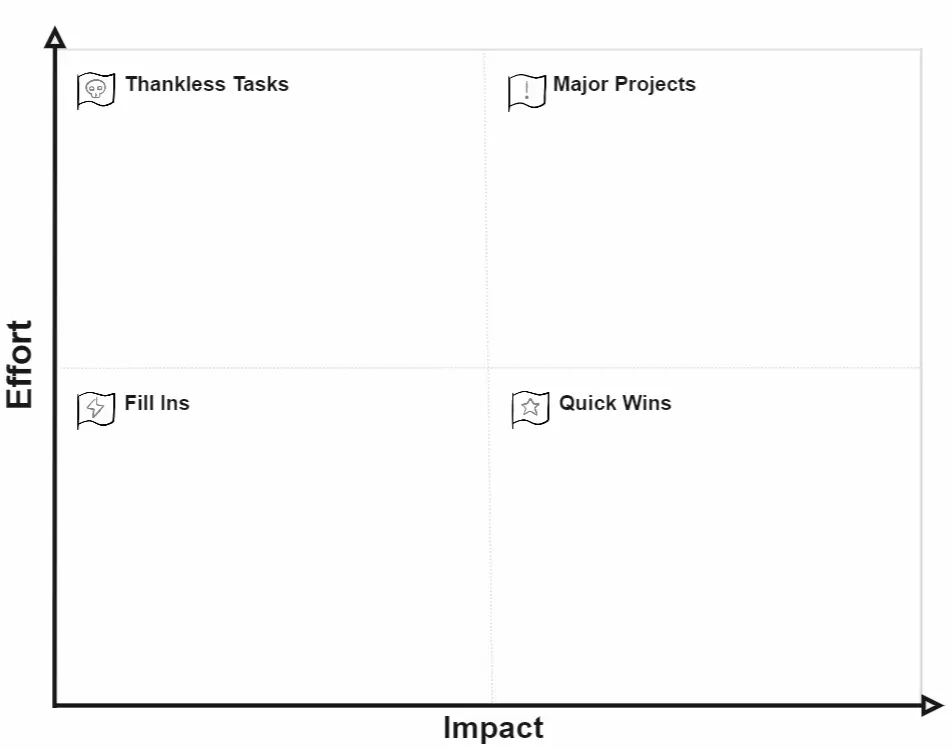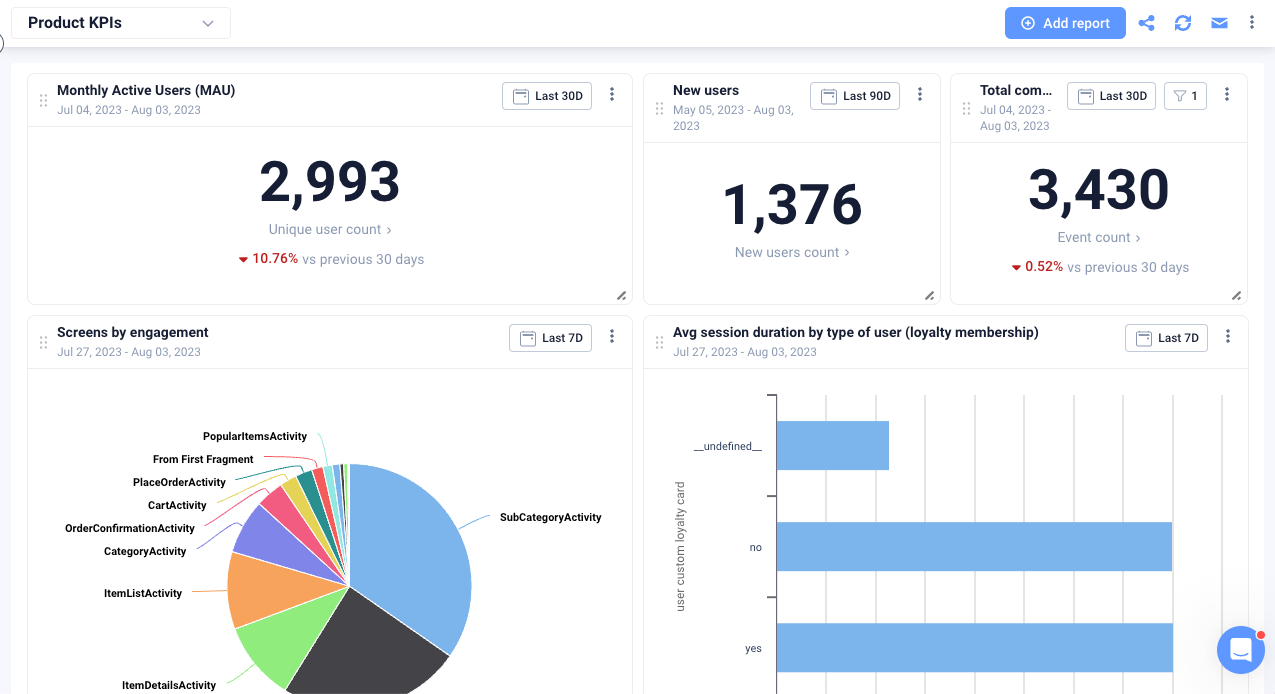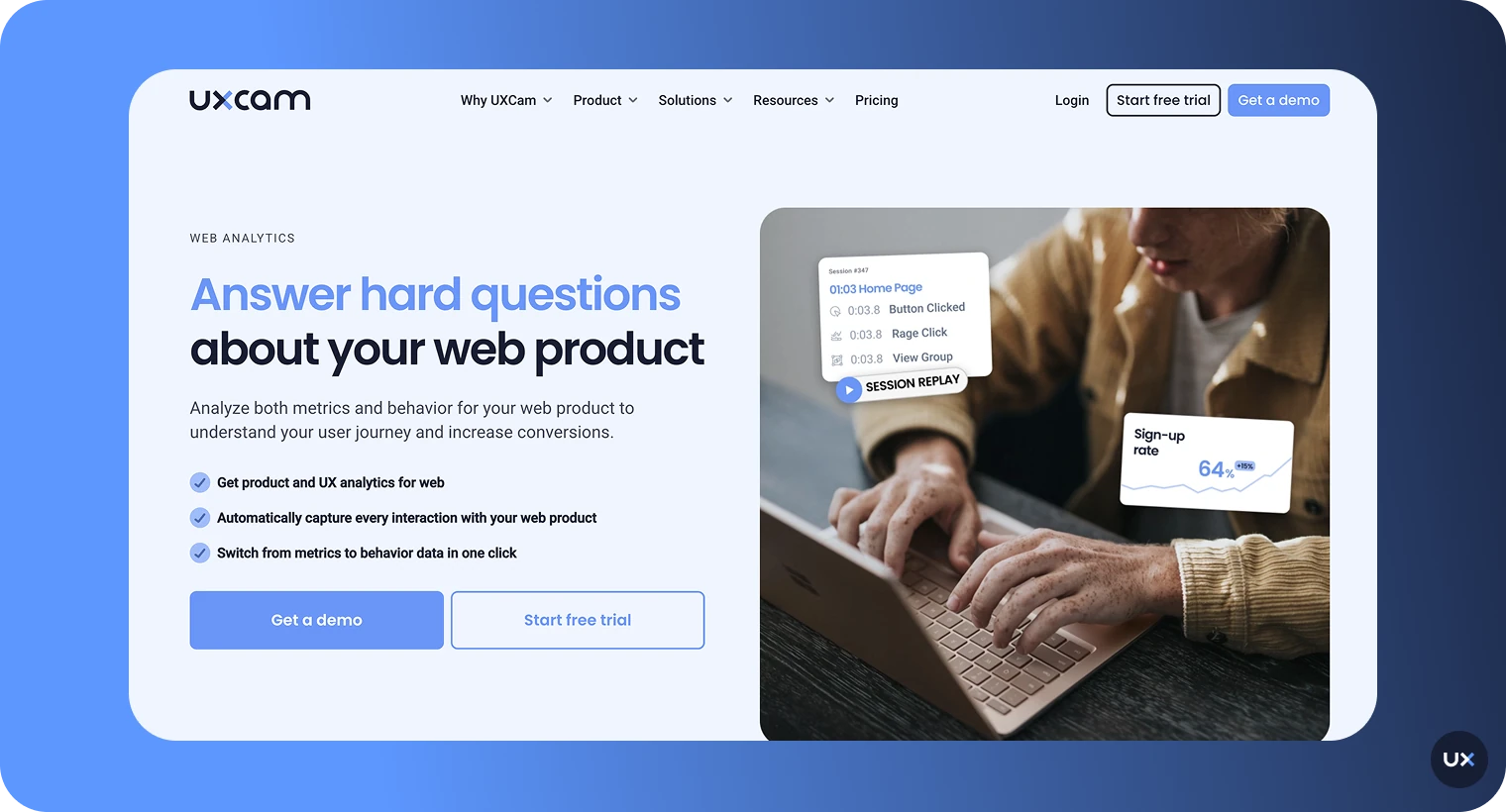Back to blog
6 MIN READ
Product Optimization - 5 Steps to Deliver a Better Product
PUBLISHED
14 January, 2025

Product Analytics Expert
Businesses must optimize their products to meet customer needs, market trends, and technological advancements and remain competitive. Product optimization is the process that makes this possible.
But what is product optimization? How does it work? What tools do you need to get started? This UXCam guide will answer all of these questions and more.
Read on to start making more targeted product improvements.
Summary - Product optimization strategy
| Steps | Summary |
|---|---|
| Choose the right tools | Collect data with analytics (UXCam), feedback tools, logs, and heatmaps. |
| Define Goals & Objectives | Identify pain points, set SMART goals, and prioritize with Impact-Effort matrix. |
| Brainstorm Solutions | Gather ideas, conduct user interviews, and target root causes with analytics. |
| Execute Plan | Assign resources, schedule tasks, outline dependencies, and set success KPIs. |
| Test Your Work | Run tests, compare changes, and track metrics in dashboards for final validation. |
What is product optimization?
Product optimization improves a product to maximize its performance, value, and impact. It involves identifying areas for improvement, making changes, and continuously iterating for the best outcome.
The specifics of the process vary. But generally, product optimization involves researching customer needs and preferences, analyzing data, assessing existing features, creating prototypes, and testing them to see how they perform.
For an example of product optimization in action, consider Inspire Fitness.

Inspire Fitness used UXCam’s session recordings, event analytics, and heatmaps to gain insights into user behavior. This helped them create a data-driven product optimization strategy built around content creation, instructor performance, and feature engagement.
The results? Inspire Fitness saw a 460% increase in time spent in-app, a 181% increase in new user sign-ups, and a 40% decrease in app crashes.
Why is product optimization important?
Enhance user experience
Effective product optimization ensures the app delivers a seamless, intuitive, and satisfying user experience. By understanding user behavior and preferences, teams can tailor the app's features, design, and functionality to meet user needs, increasing user engagement and loyalty.
For example, in 2010, Airbnb researched and realized that waiting for hosts to approve booking requests was a significant source of user frustration. They launched a new feature called “Instant Book” in response and immediately saw an increase in bookings and revenue.
Maximize performance
Through optimization, teams can identify and address performance bottlenecks, crashes, and slow loading times. This results in a more stable and responsive app, minimizing user frustration and negative reviews and maintaining a positive brand image.
Increase retention and conversion
A well-optimized app keeps users engaged and encourages them to return frequently. This leads to higher retention rates and greater opportunities for converting users into loyal customers, contributing to long-term business growth.
How to do product optimization
Whether you’re tackling usability issues, improving feature adoption, or streamlining user flows, optimization requires a structured approach backed by insights from analytics tools like UXCam. Below, we’ll walk you through actionable product optimization techniques to help you deliver value to your users while achieving measurable results for your business.
Step 1 - Choose the right analytics tools
Product optimization isn’t about hunches and guesswork—it’s about transforming data into targeted improvements. And to collect this data, you’ll need a great tech stack.
There are a few different bases you’ll want to cover here:
Product analytics: Tools (like UXCam) that track user and product behavior through event logs, session replays, heatmaps, crash logs, frustration signals, and more.
User feedback analytics: Tools that collect qualitative user feedback like ratings, reviews, and comments for sentiment and content analysis.
What exactly are you looking for?
The specifics depend on your product, but in general—pain points, user frustration, and UX bottlenecks. For example, Recora used UXCam’s heatmaps to discover that older users often tried to press and hold buttons in their app as if it were a physical remote. When this didn’t have the desired effect, they became frustrated.
Adding press-and-hold functionality decreased support calls by 142%.
Step 2 - Define your goals & objectives
Next, you’ll need to set clear, attainable goals for your product optimization efforts.
If you define the problem correctly, you almost have the solution." – Steve Jobs, Co-founder of Apple
This means diving into the data sources above to identify pain points, bottlenecks, frustration—anything impeding user interaction, productivity, or satisfaction. List these out and develop a prioritization method to set your focus.
For example, many teams use the Impact-Effort matrix:

Finally, transform your top priorities into SMART objectives by adding time constraints and success metrics. For example, if you’ve discovered that UI crashes are a common complaint, you could set the objective “to reduce UI freezes by 50% over the next six months”.
Step 3 - Brainstorm solutions
With a list of objectives, it’s time to start brainstorming the solutions (or tactics) you’ll use to achieve them.
First, ask your team and stakeholders for ideas—you’d be amazed at what insights they can provide. Then, dig into research methods such as user interviews or surveys to collect further data points that will help inform your strategy.
Finally, use analytics tools like heatmaps, session replays, and frustration signals to zero in on the root causes of your issues. Gathering this kind of qualitative data will give you a clearer picture of what needs to be addressed and how best to address it.
Step 4 - Devise & execute your product optimization plan
You now have all the core components of your product optimization plan—goals, objectives, and tactics.
Now, all you’re missing is the details. Start by assigning resources and scheduling timelines for each task. This will set expectations for the team, help you stay on track, and make it easier to hold everyone accountable.
Then, map out any key dependencies or milestones that must be achieved before the project can progress. Doing this upfront will ensure smooth progress throughout the timeline of the product optimization process.
Finally, set success metrics and KPIs for the project. These will help you measure the success of your optimization efforts, make adjustments as needed, and measure ROI.
Step 5 - Test your work against your success criteria
Last, it’s time to test your work against your success criteria. This is where you can finally see if the optimization process succeeded.
To do this, launch a series of tests that measure your changes and compare them against the initial metrics you set in the previous step. Be sure to track any resulting data to show the results clearly.


With UXCam, you can easily create high-level product dashboards to track these success metrics in real time. Drag-and-drop widgets make it easy to track key performance indicators like:
Feature engagement
Conversion rate
Load speed
Click-through rates (CTRs)
…and more.
By tracking your success criteria, you can see if the optimization process positively or negatively impacted the metrics that matter most for your product success.
What is the best product optimization solution?
When it comes to enhancing user journeys, boosting engagement, and driving business growth through data-backed improvements, UXCam stands out as the premier product optimization solution. Here’s why:

In-depth session analysis: UXCam provides session recording and replay features that help you understand exactly how users interact with your product. By pinpointing friction points and drop-off moments, you can prioritize the most impactful optimizations.
Behavioral insights & heatmaps: Get clear insights into user behavior through heatmaps that visualize taps, gestures, and scrolls. This visual approach lets you see which parts of your app resonate with users and which areas need refinement.
Advanced analytics & funnels: Monitor key metrics like conversion rates and feature adoption. UXCam’s funnel analytics help you identify and fix user bottlenecks to create a more seamless user experience.
User-centric debugging: Spot design flaws, performance issues, and unexpected crashes quickly. Reducing the time spent on guesswork means your team can focus on building new features and delivering value.
Granular insights through deep segmentation filters: Easily drill down by device type, OS version, or user cohort to understand unique behavioral patterns and fine-tune your optimizations for specific user segments.
Quick setup and faster time to insights with autocapture: Thanks to UXCam’s autocapture technology, you can start collecting important user data without complex manual event tagging, ensuring a swift, seamless integration process.
Whether you’re a startup aiming to perfect your MVP or a large enterprise refining a global product, UXCam’s powerful analytics suite provides the clarity and confidence you need to move forward. By highlighting areas of opportunity—and helping you iterate quickly—UXCam lets you transform user feedback into an actionable roadmap for lasting product success.
Conclusion
Your product should always be dynamic.
Continuous improvement through targeted product optimization allows you to keep pace with changing user demands and technological shifts.
At UXCam, we arm mobile product teams with analytics tools for targeted product optimization. Use our platform to gain insights, identify issues, and prioritize product decisions.
Get started with a 14-day free trial.
You might also be interested in these articles;
Product design process - Step-by-step guide for app ideation
Product strategy framework - 9 steps to create a winning app
5 examples of product strategy and how to create one
8 Important product management templates for mobile app teams
Product design guide - How to differentiate your app
Product management and user experience - How to collaborate effectively
AUTHOR

Tope Longe
Product Analytics Expert
Ardent technophile exploring the world of mobile app product management at UXCam.
What’s UXCam?
Related articles
App Analytics
Mobile App Tracking: Practical Guide & Best Tools [2026]
The best tracking tools for mobile...

Jonas Kurzweg
Product Analytics Expert
App Analytics
Top Analytics SDKs 2026
Pick the right analytics SDKs to improve your app's...

Jonas Kurzweg
Product Analytics Expert
Product best practices
8 Best UX Analytics Tools and Software We’ve Tested 2025
A good UX design is key when it comes to user satisfaction. Learn about five of the best UX analytics tools you can use to get valuable insights about user...

Jonas Kurzweg
Product Analytics Expert


